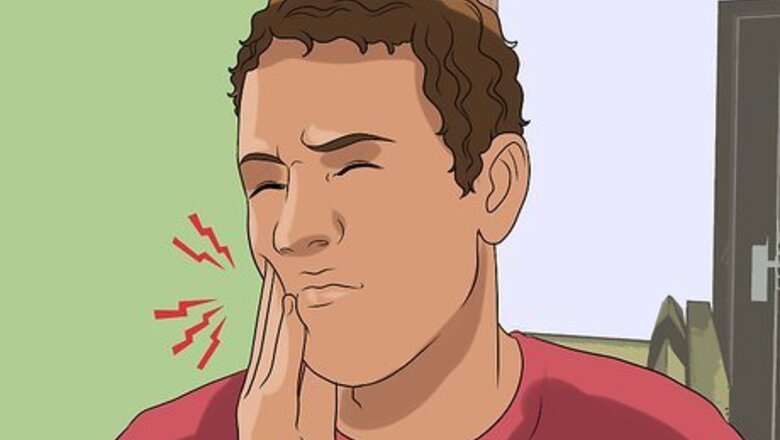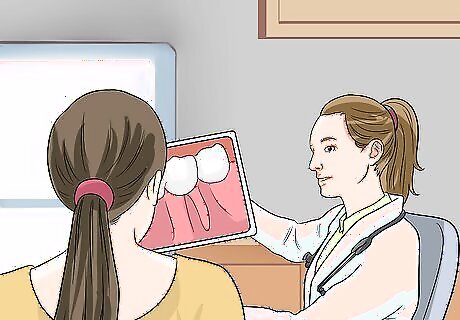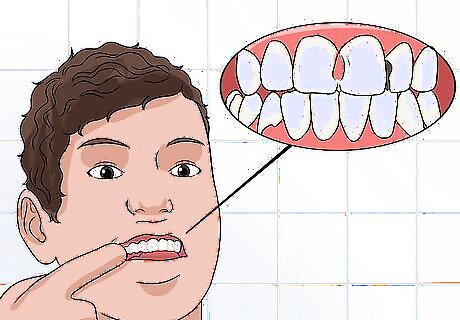
views
X
Trustworthy Source
Cleveland Clinic
Educational website from one of the world's leading hospitals
Go to source
Periapical abscesses form at the tip of a tooth's root, whereas periodontal abscesses impact your surrounding bone and gums.[2]
X
Trustworthy Source
National Health Service (UK)
Public healthcare system of the UK
Go to source
Although you might not experience any symptoms initially, a tooth abscess can cause serious medical problems. It's best to recognize it early before the infection spreads further.
Identifying a Tooth Abscess

Watch for a toothache. A toothache is one of the most common symptoms of an abscess. It often occurs as pus produced by bacteria that reached your pulp compresses the nerves in your teeth. You may notice a constant, throbbing pain around the tooth. Biting might be painful. Your tooth pain could cause sleeplessness. The pain may be localized around the tooth, but it can also radiate to the ears, jaws, neck, or cheeks. You may not be able to tell exactly where the pain is coming from. You might also feel irritated after spending a night in pain and struggling to sleep. The pain may be accompanied by a sense that your tooth is moving. The entire area around the tooth may look red and swollen. If you have a severe toothache that goes away, do not assume the abscess is gone. It is more likely that the abscess has killed the pulp and the infection remains. The pain may go for a while, especially if you have taken painkillers or an anti-inflammatory medication, but the infection will form an abscess again in no time.

Note any pain when eating or drinking. An abscess can make chewing painful. Abscesses also can make your teeth sensitive to hot and cold temperatures. If these symptoms last, seek treatment. A pericoronitis abscess is one that can be located near the lower wisdom teeth. This type of abscess can cause your masseter muscles to block (also known as trismus), making it almost impossible to open or close your mouth.

Look for swelling. As an infection grows, it can cause swelling and pain inside your mouth. Your gums may appear red and swollen and feel tender. You may also notice that your cheek looks swollen. Your gum also might swell over the impacted tooth. This could resemble a pimple.

Watch for a bad taste or smell in your mouth. If your abscess has ruptured, you will be able to smell or taste the pus. The taste will be bitter but never swallow it. Rinse with chlorhexidine mouthwash or even salt water to get rid of the taste. See your doctor immediately.

Check for other symptoms. As an abscess worsens, you might suffer a fever, and you might notice pus discharging from your gums. You also could have trouble opening your mouth, breathing, or swallowing. Swollen glands or a swollen upper or lower jaw can appear. Feeling generally sick is common. If these symptoms appear, see your dentist immediately. If the abscess breaks, you may experience a sudden relief from the pain along with a salty taste. You should still see your dentist right away.

Visit the dentist. If you have noticed the above symptoms, see a dentist. He or she will tap your tooth to see if it is sensitive. You likely will receive an x-ray. Then your dentist can know for sure whether you have an abscess. An abscess is a serious problem. You should visit the dentist as soon as possible. A dentist can identify the source of the abscess, prescribe painkillers and antibiotics, and treat the abscess itself (i.e. through draining, root canal, or tooth extraction).
Preventing a Tooth Abscess

Maintain good dental hygiene. Brush your teeth twice daily. Also, try to floss once daily. If you neglect your teeth, you have a higher risk of developing tooth abscesses.

Avoid sugary foods. If you constantly eat foods high in sugar (e.g. candy, chocolate), you can increase your risk for cavities. Cavities can lead eventually to abscesses. Some sugary foods are fine but eat them in moderation. If possible, brush afterwards.

Watch for cavities and fractures. If you have an untreated cavity or a tooth fracture that reaches the dental pulp (inner part of your tooth), you risk developing an abscess. This happens when bacteria reaches your dental pulp, which is the inside of your tooth. See a dentist as soon as possible, and watch for any symptoms. Cavities and trauma typically lead to a “periapical abscess.”

Pay attention to your gums. An injury to the gums can cause an abscess. Gum disease causes the space between the tooth and the gum to widen, which allows bacteria to enter. This bacteria can cause an abscess, even if the teeth are healthy and cavity-free. If you have any issues with your gums, watch for symptoms of an abscess. Gum injuries and gum disease typically lead to a particular kind of infection known as a “gingival abscess” (or “gum abscess”). If the infection extends to the gum pockets, and the draining of pus is blocked by the swallowed gum, it is then called a “periodontal abscess.”

















Comments
0 comment